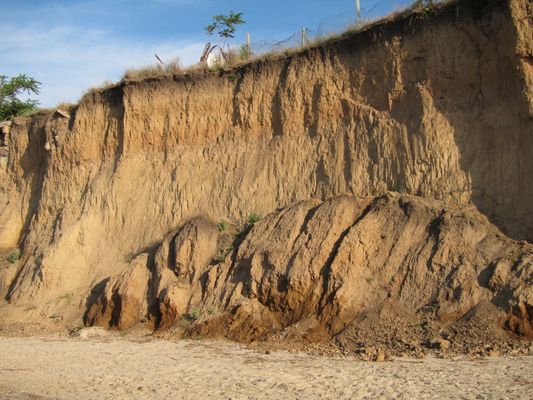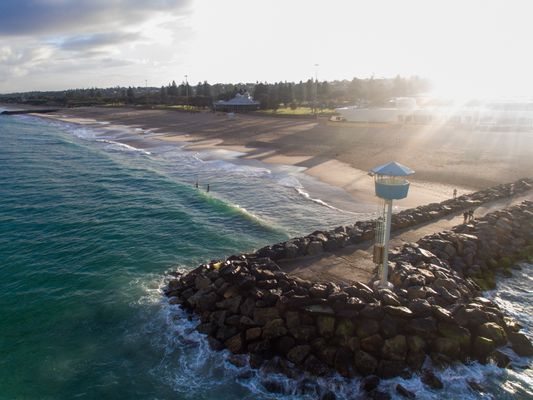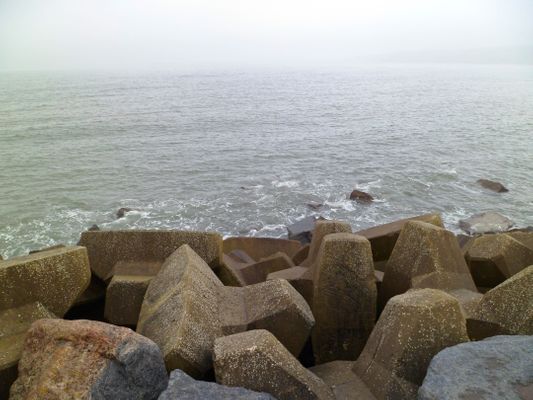3.2.16
Coastal Management Case Study - Holderness
Coastal Erosion in Holderness
Coastal Erosion in Holderness
The Holderness coast is located next to the city of Hull in the north-east of England. Each year, the Holderness Coast retreats 1-2 metres. The area is particularly vulnerable to erosion because of:


Strong prevailing winds
Strong prevailing winds
- Strong prevailing winds create destructive waves that can do more damage to the coast.
- The prevailing winds also mean that any eroded material moves away from the place that was eroded (leaving the soft rock exposed).


Clay cliffs
Clay cliffs
- The Holderness Coast is made of boulder clay.
- This is very soft and easy to erode.
- Heavy rainfall can cause mass movements in the boulder clay cliffs.
Coastal Management in Holderness
Coastal Management in Holderness
In 1991, a £2 million project built rock groynes and rock revetments at Mappleton in the Holderness coast. These are examples of hard engineering.


Rock groynes
Rock groynes
- The rock groynes tried to stop sediment being carried away from the Holderness Coast and tried to create a larger beach to protect the land behind.


Rock armour
Rock armour
- Rock armour was placed at the foot of the cliffs.
- The rock armour is meant to absorb some of the waves' energy, instead of the coast or cliffs.
What are the Results & Effects of Coastal Management at Mappleton?
What are the Results & Effects of Coastal Management at Mappleton?
The cliffs at Mappleton now erode at 1-2 metres per year, instead of the 7-10 metres before 1991. Mappleton now has a larger beach, however, there have been some negative effects:


Area south of Mappleton
Area south of Mappleton
- The area south of Mappleton is experiencing faster coastal erosion as a byproduct.


Spurn Point
Spurn Point
- The Spurn Point area south, has become less secure.
- Less material is washed down the Holderness Coast.
- Some Hebridean Sheep were washed away and killed. People are now warned not to visit the Point at some times of year, or they too could be washed away.


Spurn Point lifeboat & visitor's centre
Spurn Point lifeboat & visitor's centre
- £471,000 was spent on a visitor's centre which could become less accessible over time.
- Lifeboat services also operate from Spurn Point.
1The Challenge of Natural Hazards
1.1Natural Hazards
1.2Tectonic Hazards
1.2.1The Earth's Layers
1.2.2Tectonic Plates
1.2.3The Earth's Tectonic Plates
1.2.4Convection Currents
1.2.5Plate Margins
1.2.6Volcanoes
1.2.7Volcano Eruptions
1.2.8Effects of Volcanoes
1.2.9Primary Effects of Volcanoes
1.2.10Secondary Effects of Volcanoes
1.2.11Responses to Volcanic Eruptions
1.2.12Immediate Responses to Volcanoes
1.2.13Long-Term Responses to Volcanoes
1.2.14Earthquakes
1.2.15Earthquakes at Different Plate Margins
1.2.16What is an Earthquake?
1.2.17Measuring Earthquakes
1.2.18Immediate Responses to Earthquakes
1.2.19Long-Term Responses to Earthquakes
1.2.20Case Studies: The L'Aquila Earthquake
1.2.21Case Studies: The Kashmir Earthquake
1.2.22Earthquake Case Study: Chile 2010
1.2.23Earthquake Case Study: Nepal 2015
1.2.24Reducing the Impact of Tectonic Hazards
1.2.25Protecting & Planning
1.2.26Living with Tectonic Hazards 2
1.2.27End of Topic Test - Tectonic Hazards
1.2.28Exam-Style Questions - Tectonic Hazards
1.2.29Tectonic Hazards - Statistical Skills
1.2.30Diagnostic Misconceptions - Lava
1.2.31Diagnostic Misconceptions - Locations of Volcanoes
1.2.32Diagnostic Misconceptions - Focus vs Epicentre
1.2.33Diagnostic Misconceptions - Plates Sliding
1.3Weather Hazards
1.3.1Winds & Pressure
1.3.2The Global Atmospheric Circulation Model
1.3.3Surface Winds
1.3.4UK Weather Hazards
1.3.5Changing Weather in the UK
1.3.6Tropical Storms
1.3.7Tropical Storm Causes
1.3.8Features of Tropical Storms
1.3.9The Structure of Tropical Storms
1.3.10The Effect of Climate Change on Tropical Storms
1.3.11The Effects of Tropical Storms
1.3.12Responses to Tropical Storms
1.3.13Reducing the Effects of Tropical Storms
1.3.14Tropical Storms Case Study: Katrina - Effects
1.3.15Tropical Storms Case Study: Katrina - Responses
1.3.16Tropical Storms Case Study: Haiyan
1.3.17UK Weather Hazards Case Study: Somerset 2014
1.3.18Effects & Responses
1.3.19End of Topic Test - Weather Hazards
1.3.20Exam-Style Questions - Weather Hazards
1.3.21Weather Hazards - Statistical Skills
1.4Climate Change
1.4.1Climate Change
1.4.2Evidence for Climate Change
1.4.3Natural Causes of Climate Change
1.4.4Human Causes of Climate Change
1.4.5Effects of Climate Change on the Environment
1.4.6Effects of Climate Change on People
1.4.7Climate Change Mitigation Strategies
1.4.8Adaptation to Climate Change
1.4.9End of Topic Test - Climate Change
1.4.10Exam-Style Questions - Climate Change
1.4.11Climate Change - Statistical Skills
1.4.12Diagnostic Misconceptions - Greenhouse Effect
1.4.13Diagnostic Misconceptions - 1°C change in Temp.
2The Living World
2.1Ecosystems
2.2Tropical Rainforests
2.2.1Tropical Rainforests
2.2.2Interdependence of Tropical Rainforests
2.2.3Adaptations of Plants to Rainforests
2.2.4Adaptations of Animals to Rainforests
2.2.5Biodiversity of Tropical Rainforests
2.2.6Deforestation
2.2.7Impacts of Deforestation
2.2.8Case Study: Deforestation in the Amazon Rainforest
2.2.9Why Protect Rainforests?
2.2.10Sustainable Management of Rainforests
2.2.11Case Study: Malaysian Rainforest
2.2.12End of Topic Test - Tropical Rainforests
2.2.13Exam-Style Questions - Tropical Rainforests
2.2.14Deforestation - Statistical Skills
2.2.15Diagnostic Misconceptions - Rainfall
2.3Hot Deserts
2.3.1Hot Deserts
2.3.2Interdependence in Hot Deserts
2.3.3Adaptation of Plants to Hot Deserts
2.3.4Adaptation of Animals to Hot Deserts
2.3.5Biodiversity in Hot Deserts
2.3.6Case Study: Sahara Desert
2.3.7Desertification
2.3.8Reducing the Risk of Desertification
2.3.9Case Study: Thar Desert
2.3.10End of Topic Test - Hot Deserts
2.3.11Exam-Style Questions - Hot Deserts
2.3.12Diagnostic Misconceptions - Location of Hot Desert
2.4Tundra & Polar Environments
2.4.1Overview of Cold Environments
2.4.2Interdependence of Cold Environments
2.4.3Adaptations of Plants to Cold Environments
2.4.4Adaptations of Animals to Cold Environments
2.4.5Biodiversity in Cold Environments
2.4.6Case Study: Alaska
2.4.7Sustainable Management
2.4.8Case Study: Svalbard
2.4.9End of Topic Test - Tundra & Polar Environments
2.4.10Exam-Style Questions - Cold Environments
2.4.11Diagnostic Misconceptions - Permafrost
3Physical Landscapes in the UK
3.1The UK Physical Landscape
3.2Coastal Landscapes in the UK
3.2.1Types of Wave
3.2.2Weathering
3.2.3Mass Movement
3.2.4Processes of Erosion
3.2.5Wave-Cut Platforms
3.2.6Headlands & Bays
3.2.7Caves, Arches & Stacks
3.2.8Longshore Drift
3.2.9Sediment Transportation
3.2.10Deposition
3.2.11Spits, Bars & Sand Dunes
3.2.12Coastal Management - Hard Engineering
3.2.13Coastal Management - Soft Engineering
3.2.14Case Study: Landforms on the Dorset Coast
3.2.15Coastal Management - Managed Retreat
3.2.16Coastal Management Case Study - Holderness
3.2.17Coastal Management Case Study: Swanage
3.2.18Coastal Management Case Study - Lyme Regis
3.2.19End of Topic Test - Coastal Landscapes in the UK
3.2.20Exam-Style Questions - Coasts
3.2.21Diagnostic Misconceptions - Swash & Backwash
3.3River Landscapes in the UK
3.3.1The Long Profile of a River
3.3.2The Cross Profile of a River
3.3.3Vertical & Lateral Erosion
3.3.4River Valley Case Study - River Tees
3.3.5Processes of Erosion
3.3.6Sediment Transport
3.3.7River Deposition
3.3.8Waterfalls & Gorges
3.3.9Interlocking Spurs
3.3.10Meanders
3.3.11Oxbow Lakes
3.3.12Floodplains
3.3.13Levees
3.3.14Estuaries
3.3.15Case Study: The River Clyde
3.3.16River Management
3.3.17Hydrographs
3.3.18Flood Defences - Hard Engineering
3.3.19Flood Defences - Soft Engineering
3.3.20River Management Case Study - Boscastle
3.3.21River Management Case Study - Banbury
3.3.22End of Topic Test - River Landscapes in the UK
3.3.23Exam-Style Questions - Rivers
3.3.24Diagnostic Misconceptions - Upper Course
3.3.25Diagnostic Misconceptions - Deposition
3.4Glacial Landscapes in the UK
3.4.1The UK in the Last Ice Age
3.4.2Glacial Processes
3.4.3Glacial Landforms Caused by Erosion
3.4.4Tarns, Corries, Glacial Troughs & Truncated Spurs
3.4.5Types of Moraine
3.4.6Drumlins & Erratics
3.4.7Snowdonia
3.4.8Land Use in Glaciated Areas
3.4.9Conflicts in Glacial Landscapes
3.4.10Tourism in Glacial Landscapes
3.4.11Coping with Tourism Impacts in Glacial Landscapes
3.4.12Case Study - Lake District
3.4.13End of Topic Test - Glacial Landscapes in the UK
3.4.14Exam-Style Questions - Glacial Landscapes
3.4.15Diagnostic Misconceptions - Glacial Retreat
4Urban Issues & Challenges
4.1Urban Issues & Challenges
4.1.1Urbanisation
4.1.2Factors Causing Urbanisation
4.1.3Megacities
4.1.4Urbanisation Case Study: Lagos
4.1.5Urbanisation Case Study: Rio de Janeiro
4.1.6UK Cities
4.1.7Case Study: Urban Regen Projects - Manchester
4.1.8Case Study: Urban Change in Liverpool
4.1.9Case Study: Urban Change in Bristol
4.1.10Sustainable Urban Life
4.1.11Reducing Traffic Congestion
4.1.12End of Topic Test - Urban Issues & Challenges
4.1.13Exam-Style Questions - Urban Issues & Challenges
4.1.14Urban Issues -Statistical Skills
4.1.15Diagnostic Misconceptions - Urbanisation
4.1.16Diagnostic Misconceptions - Megacities
5The Changing Economic World
5.1The Changing Economic World
5.1.1Measuring Development
5.1.2Limitations of Developing Measures
5.1.3Classifying Countries Based on Wealth
5.1.4The Demographic Transition Model
5.1.5Stages of the Demographic Transition Model
5.1.6Physical Causes of Uneven Development
5.1.7Historical Causes of Uneven Development
5.1.8Economic Causes of Uneven Development
5.1.9Consequences of Uneven Development
5.1.10How Can We Reduce the Global Development Gap?
5.1.11Case Study: Tourism in Kenya
5.1.12Case Study: Tourism in Jamaica
5.1.13Case Study: Economic Development in India
5.1.14Case Study: India's Changing Industrial Structure
5.1.15Case Study: TNCs in India
5.1.16Case Study: India's Relationship with the World
5.1.17Case Study: Aid Received by India
5.1.18Case Study: Impacts of Development in India
5.1.19Case Study: Economic Development in Nigeria
5.1.20Case Study: Nigeria's Industries
5.1.21Case Study: TNCs in Nigeria
5.1.22Case Study: Nigeria's Relationship with the World
5.1.23Case Study: Aid in Nigeria
5.1.24Case Study: Impacts of Development in Nigeria
5.1.25End of Topic Test - The Changing Economic World
5.1.26Exam-Style Questions - The Changing Economic World
5.1.27Changing Economic World - Statistical Skills
5.1.28Diagnostic Misconceptions - Decreasing Birth Rate
5.1.29Diagnostic Misconceptions - Inequality
5.1.30Diagnostic Misconceptions - African Development
5.2Economic Development in the UK
6The Challenge of Resource Management
6.1Resource Management
6.1.1Global Distribution of Resources
6.1.2Uneven Distribution of Resources
6.1.3Food in the UK
6.1.4Agribusiness
6.1.5Demand for Water in the UK
6.1.6Water Pollution in the UK
6.1.7Matching Supply & Demand of Water in the UK
6.1.8The UK's Energy Mix
6.1.9Issues with Sources of Energy
6.1.10Resource Management - Statistical Skills
6.2Food
6.2.1Areas of Food Surplus & Food Deficit
6.2.2Increasing Food Consumption
6.2.3Food Supply & Food Insecurity
6.2.4Impacts of Food Insecurity
6.2.5Increasing Food Supply
6.2.6Case Study: Thanet Earth
6.2.7Creating a Sustainable Food Supply
6.2.8Case Study: Agroforestry in Mali
6.2.9End of Topic Test - Food
6.2.10Exam-Style Questions - Food
6.2.11Food - Statistical Skills
6.2.12Diagnostic Misconceptions - Amount of Food
6.3Water
6.3.1Water Surplus & Water Deficit
6.3.2Increasing Water Consumption
6.3.3What Affects the Availability of Water?
6.3.4Impacts of Water Insecurity
6.3.5Increasing Water Supplies
6.3.6Case Study: Water Transfer in China
6.3.7Sustainable Water Supply
6.3.8Case Study: Kenya's Sand Dams
6.3.9Case Study: Lesotho Highland Water Project
6.3.10Case Study: Wakel River Basin Project
6.3.11Exam-Style Questions - Water
6.3.12Water - Statistical Skills
6.4Energy
6.4.1Global Demand for Energy
6.4.2Increasing Energy Consumption
6.4.3Factors Affecting Energy Supply
6.4.4Impacts of Energy Insecurity
6.4.5Increasing Energy Supply - Solar
6.4.6Increasing Energy Supply - Water
6.4.7Increasing Energy Supply - Wind
6.4.8Increasing Energy Supply - Nuclear
6.4.9Increasing Energy Supply - Fossil Fuels
6.4.10Carbon Footprints
6.4.11Energy Conservation
6.4.12Case Study: Rice Husks in Bihar
6.4.13Exam-Style Questions - Energy
6.4.14Energy - Statistical Skills
Jump to other topics
1The Challenge of Natural Hazards
1.1Natural Hazards
1.2Tectonic Hazards
1.2.1The Earth's Layers
1.2.2Tectonic Plates
1.2.3The Earth's Tectonic Plates
1.2.4Convection Currents
1.2.5Plate Margins
1.2.6Volcanoes
1.2.7Volcano Eruptions
1.2.8Effects of Volcanoes
1.2.9Primary Effects of Volcanoes
1.2.10Secondary Effects of Volcanoes
1.2.11Responses to Volcanic Eruptions
1.2.12Immediate Responses to Volcanoes
1.2.13Long-Term Responses to Volcanoes
1.2.14Earthquakes
1.2.15Earthquakes at Different Plate Margins
1.2.16What is an Earthquake?
1.2.17Measuring Earthquakes
1.2.18Immediate Responses to Earthquakes
1.2.19Long-Term Responses to Earthquakes
1.2.20Case Studies: The L'Aquila Earthquake
1.2.21Case Studies: The Kashmir Earthquake
1.2.22Earthquake Case Study: Chile 2010
1.2.23Earthquake Case Study: Nepal 2015
1.2.24Reducing the Impact of Tectonic Hazards
1.2.25Protecting & Planning
1.2.26Living with Tectonic Hazards 2
1.2.27End of Topic Test - Tectonic Hazards
1.2.28Exam-Style Questions - Tectonic Hazards
1.2.29Tectonic Hazards - Statistical Skills
1.2.30Diagnostic Misconceptions - Lava
1.2.31Diagnostic Misconceptions - Locations of Volcanoes
1.2.32Diagnostic Misconceptions - Focus vs Epicentre
1.2.33Diagnostic Misconceptions - Plates Sliding
1.3Weather Hazards
1.3.1Winds & Pressure
1.3.2The Global Atmospheric Circulation Model
1.3.3Surface Winds
1.3.4UK Weather Hazards
1.3.5Changing Weather in the UK
1.3.6Tropical Storms
1.3.7Tropical Storm Causes
1.3.8Features of Tropical Storms
1.3.9The Structure of Tropical Storms
1.3.10The Effect of Climate Change on Tropical Storms
1.3.11The Effects of Tropical Storms
1.3.12Responses to Tropical Storms
1.3.13Reducing the Effects of Tropical Storms
1.3.14Tropical Storms Case Study: Katrina - Effects
1.3.15Tropical Storms Case Study: Katrina - Responses
1.3.16Tropical Storms Case Study: Haiyan
1.3.17UK Weather Hazards Case Study: Somerset 2014
1.3.18Effects & Responses
1.3.19End of Topic Test - Weather Hazards
1.3.20Exam-Style Questions - Weather Hazards
1.3.21Weather Hazards - Statistical Skills
1.4Climate Change
1.4.1Climate Change
1.4.2Evidence for Climate Change
1.4.3Natural Causes of Climate Change
1.4.4Human Causes of Climate Change
1.4.5Effects of Climate Change on the Environment
1.4.6Effects of Climate Change on People
1.4.7Climate Change Mitigation Strategies
1.4.8Adaptation to Climate Change
1.4.9End of Topic Test - Climate Change
1.4.10Exam-Style Questions - Climate Change
1.4.11Climate Change - Statistical Skills
1.4.12Diagnostic Misconceptions - Greenhouse Effect
1.4.13Diagnostic Misconceptions - 1°C change in Temp.
2The Living World
2.1Ecosystems
2.2Tropical Rainforests
2.2.1Tropical Rainforests
2.2.2Interdependence of Tropical Rainforests
2.2.3Adaptations of Plants to Rainforests
2.2.4Adaptations of Animals to Rainforests
2.2.5Biodiversity of Tropical Rainforests
2.2.6Deforestation
2.2.7Impacts of Deforestation
2.2.8Case Study: Deforestation in the Amazon Rainforest
2.2.9Why Protect Rainforests?
2.2.10Sustainable Management of Rainforests
2.2.11Case Study: Malaysian Rainforest
2.2.12End of Topic Test - Tropical Rainforests
2.2.13Exam-Style Questions - Tropical Rainforests
2.2.14Deforestation - Statistical Skills
2.2.15Diagnostic Misconceptions - Rainfall
2.3Hot Deserts
2.3.1Hot Deserts
2.3.2Interdependence in Hot Deserts
2.3.3Adaptation of Plants to Hot Deserts
2.3.4Adaptation of Animals to Hot Deserts
2.3.5Biodiversity in Hot Deserts
2.3.6Case Study: Sahara Desert
2.3.7Desertification
2.3.8Reducing the Risk of Desertification
2.3.9Case Study: Thar Desert
2.3.10End of Topic Test - Hot Deserts
2.3.11Exam-Style Questions - Hot Deserts
2.3.12Diagnostic Misconceptions - Location of Hot Desert
2.4Tundra & Polar Environments
2.4.1Overview of Cold Environments
2.4.2Interdependence of Cold Environments
2.4.3Adaptations of Plants to Cold Environments
2.4.4Adaptations of Animals to Cold Environments
2.4.5Biodiversity in Cold Environments
2.4.6Case Study: Alaska
2.4.7Sustainable Management
2.4.8Case Study: Svalbard
2.4.9End of Topic Test - Tundra & Polar Environments
2.4.10Exam-Style Questions - Cold Environments
2.4.11Diagnostic Misconceptions - Permafrost
3Physical Landscapes in the UK
3.1The UK Physical Landscape
3.2Coastal Landscapes in the UK
3.2.1Types of Wave
3.2.2Weathering
3.2.3Mass Movement
3.2.4Processes of Erosion
3.2.5Wave-Cut Platforms
3.2.6Headlands & Bays
3.2.7Caves, Arches & Stacks
3.2.8Longshore Drift
3.2.9Sediment Transportation
3.2.10Deposition
3.2.11Spits, Bars & Sand Dunes
3.2.12Coastal Management - Hard Engineering
3.2.13Coastal Management - Soft Engineering
3.2.14Case Study: Landforms on the Dorset Coast
3.2.15Coastal Management - Managed Retreat
3.2.16Coastal Management Case Study - Holderness
3.2.17Coastal Management Case Study: Swanage
3.2.18Coastal Management Case Study - Lyme Regis
3.2.19End of Topic Test - Coastal Landscapes in the UK
3.2.20Exam-Style Questions - Coasts
3.2.21Diagnostic Misconceptions - Swash & Backwash
3.3River Landscapes in the UK
3.3.1The Long Profile of a River
3.3.2The Cross Profile of a River
3.3.3Vertical & Lateral Erosion
3.3.4River Valley Case Study - River Tees
3.3.5Processes of Erosion
3.3.6Sediment Transport
3.3.7River Deposition
3.3.8Waterfalls & Gorges
3.3.9Interlocking Spurs
3.3.10Meanders
3.3.11Oxbow Lakes
3.3.12Floodplains
3.3.13Levees
3.3.14Estuaries
3.3.15Case Study: The River Clyde
3.3.16River Management
3.3.17Hydrographs
3.3.18Flood Defences - Hard Engineering
3.3.19Flood Defences - Soft Engineering
3.3.20River Management Case Study - Boscastle
3.3.21River Management Case Study - Banbury
3.3.22End of Topic Test - River Landscapes in the UK
3.3.23Exam-Style Questions - Rivers
3.3.24Diagnostic Misconceptions - Upper Course
3.3.25Diagnostic Misconceptions - Deposition
3.4Glacial Landscapes in the UK
3.4.1The UK in the Last Ice Age
3.4.2Glacial Processes
3.4.3Glacial Landforms Caused by Erosion
3.4.4Tarns, Corries, Glacial Troughs & Truncated Spurs
3.4.5Types of Moraine
3.4.6Drumlins & Erratics
3.4.7Snowdonia
3.4.8Land Use in Glaciated Areas
3.4.9Conflicts in Glacial Landscapes
3.4.10Tourism in Glacial Landscapes
3.4.11Coping with Tourism Impacts in Glacial Landscapes
3.4.12Case Study - Lake District
3.4.13End of Topic Test - Glacial Landscapes in the UK
3.4.14Exam-Style Questions - Glacial Landscapes
3.4.15Diagnostic Misconceptions - Glacial Retreat
4Urban Issues & Challenges
4.1Urban Issues & Challenges
4.1.1Urbanisation
4.1.2Factors Causing Urbanisation
4.1.3Megacities
4.1.4Urbanisation Case Study: Lagos
4.1.5Urbanisation Case Study: Rio de Janeiro
4.1.6UK Cities
4.1.7Case Study: Urban Regen Projects - Manchester
4.1.8Case Study: Urban Change in Liverpool
4.1.9Case Study: Urban Change in Bristol
4.1.10Sustainable Urban Life
4.1.11Reducing Traffic Congestion
4.1.12End of Topic Test - Urban Issues & Challenges
4.1.13Exam-Style Questions - Urban Issues & Challenges
4.1.14Urban Issues -Statistical Skills
4.1.15Diagnostic Misconceptions - Urbanisation
4.1.16Diagnostic Misconceptions - Megacities
5The Changing Economic World
5.1The Changing Economic World
5.1.1Measuring Development
5.1.2Limitations of Developing Measures
5.1.3Classifying Countries Based on Wealth
5.1.4The Demographic Transition Model
5.1.5Stages of the Demographic Transition Model
5.1.6Physical Causes of Uneven Development
5.1.7Historical Causes of Uneven Development
5.1.8Economic Causes of Uneven Development
5.1.9Consequences of Uneven Development
5.1.10How Can We Reduce the Global Development Gap?
5.1.11Case Study: Tourism in Kenya
5.1.12Case Study: Tourism in Jamaica
5.1.13Case Study: Economic Development in India
5.1.14Case Study: India's Changing Industrial Structure
5.1.15Case Study: TNCs in India
5.1.16Case Study: India's Relationship with the World
5.1.17Case Study: Aid Received by India
5.1.18Case Study: Impacts of Development in India
5.1.19Case Study: Economic Development in Nigeria
5.1.20Case Study: Nigeria's Industries
5.1.21Case Study: TNCs in Nigeria
5.1.22Case Study: Nigeria's Relationship with the World
5.1.23Case Study: Aid in Nigeria
5.1.24Case Study: Impacts of Development in Nigeria
5.1.25End of Topic Test - The Changing Economic World
5.1.26Exam-Style Questions - The Changing Economic World
5.1.27Changing Economic World - Statistical Skills
5.1.28Diagnostic Misconceptions - Decreasing Birth Rate
5.1.29Diagnostic Misconceptions - Inequality
5.1.30Diagnostic Misconceptions - African Development
5.2Economic Development in the UK
6The Challenge of Resource Management
6.1Resource Management
6.1.1Global Distribution of Resources
6.1.2Uneven Distribution of Resources
6.1.3Food in the UK
6.1.4Agribusiness
6.1.5Demand for Water in the UK
6.1.6Water Pollution in the UK
6.1.7Matching Supply & Demand of Water in the UK
6.1.8The UK's Energy Mix
6.1.9Issues with Sources of Energy
6.1.10Resource Management - Statistical Skills
6.2Food
6.2.1Areas of Food Surplus & Food Deficit
6.2.2Increasing Food Consumption
6.2.3Food Supply & Food Insecurity
6.2.4Impacts of Food Insecurity
6.2.5Increasing Food Supply
6.2.6Case Study: Thanet Earth
6.2.7Creating a Sustainable Food Supply
6.2.8Case Study: Agroforestry in Mali
6.2.9End of Topic Test - Food
6.2.10Exam-Style Questions - Food
6.2.11Food - Statistical Skills
6.2.12Diagnostic Misconceptions - Amount of Food
6.3Water
6.3.1Water Surplus & Water Deficit
6.3.2Increasing Water Consumption
6.3.3What Affects the Availability of Water?
6.3.4Impacts of Water Insecurity
6.3.5Increasing Water Supplies
6.3.6Case Study: Water Transfer in China
6.3.7Sustainable Water Supply
6.3.8Case Study: Kenya's Sand Dams
6.3.9Case Study: Lesotho Highland Water Project
6.3.10Case Study: Wakel River Basin Project
6.3.11Exam-Style Questions - Water
6.3.12Water - Statistical Skills
6.4Energy
6.4.1Global Demand for Energy
6.4.2Increasing Energy Consumption
6.4.3Factors Affecting Energy Supply
6.4.4Impacts of Energy Insecurity
6.4.5Increasing Energy Supply - Solar
6.4.6Increasing Energy Supply - Water
6.4.7Increasing Energy Supply - Wind
6.4.8Increasing Energy Supply - Nuclear
6.4.9Increasing Energy Supply - Fossil Fuels
6.4.10Carbon Footprints
6.4.11Energy Conservation
6.4.12Case Study: Rice Husks in Bihar
6.4.13Exam-Style Questions - Energy
6.4.14Energy - Statistical Skills
Unlock your full potential with Seneca Premium
Unlimited access to 10,000+ open-ended exam questions
Mini-mock exams based on your study history
Unlock 800+ premium courses & e-books